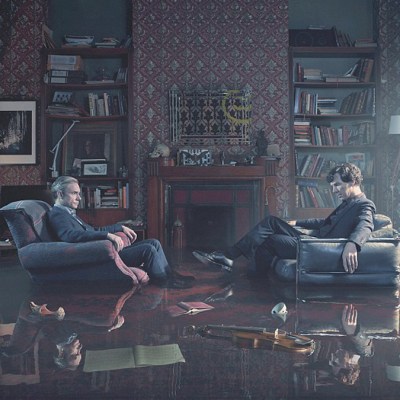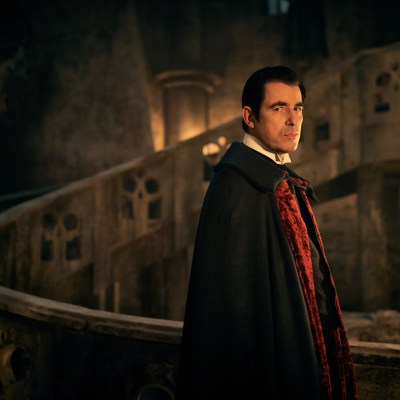BBC/Netflix Dracula’s Behind-the-Scenes Set Secrets
Production designer Arwel W Jones tells us where to look for Easter Eggs, Sherlock crossovers, and design details in the BBC/Netflix Dracula
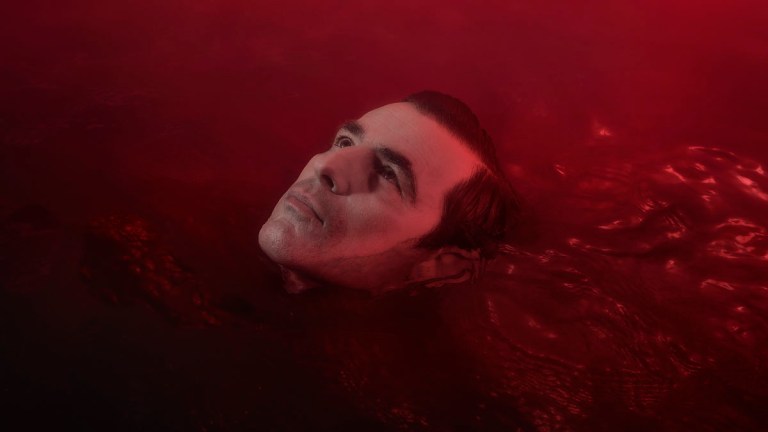
Contains Dracula episode 1-3 spoilers
Bela Lugosi’s aside, Castle Dracula can often be a let-down, says Arwel W Jones. Tasked with creating his own take on the Transylvanian fortress for 2020 three-part adaptation Dracula, the production designer rewatched countless versions of the story. “You’d see this magnificent castle from afar, and then, due to budget restrictions I assume, you’d end up disappointed by the interior. As you get closer to the front door and the entranceway, it always tended to be a slightly smaller deal.”
For the BBC/Netflix series written by Steven Moffat and Mark Gatiss and starring Claes Bang in the title role, Jones had to make the castle a big deal. “Scale was one of my mantras. I wanted to convey the scale of the castle, to give a sense of awe, and then for it to carry on inside with a feeling of unease.”
The exteriors were already there, thanks to filming at Orava Castle in Slovakia, a location for 1922 silent film Nosferatu. Inside, it took a monumental dragon-shaped staircase, candles in their thousands, skulls, taxidermy, and some extremely clever design work to conjure up the vast and unsettling world of the Count.
Unveiling Easter Egg secrets and tributes paid to other famous screen horror, as well as one or two links to Gatiss and Moffat’s Sherlock, here’s how it was done…
Celebrity Portrait Artist
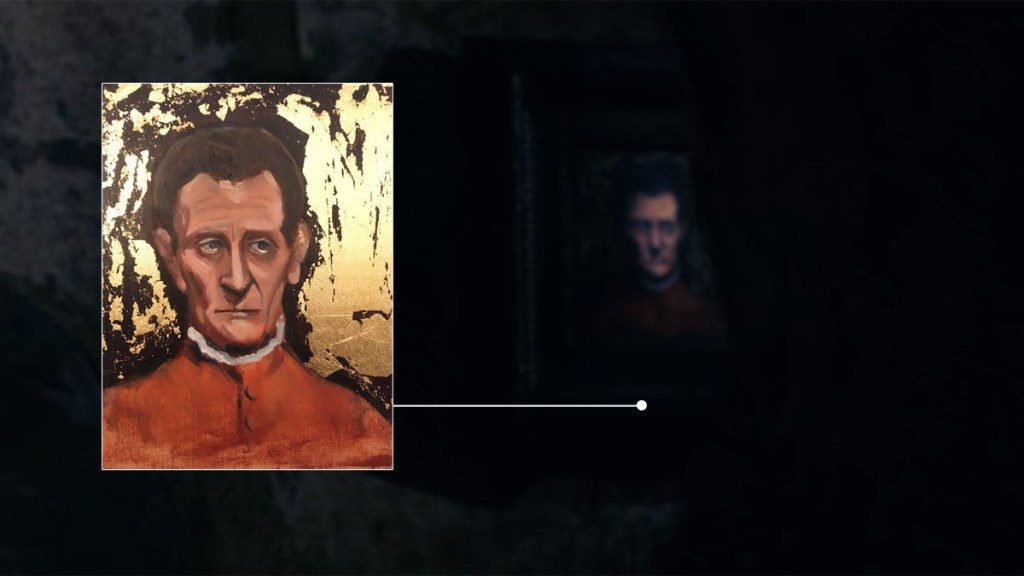
Mark Gatiss is a man of many talents. The co-writer of Dracula and actor behind Frank Renfield (the Count’s thrall and, in this version, lawyer), is also an artist whose love of horror finds expression on the canvas. In preparation for Dracula, Gatiss showed production designer Arwel W Jones a portrait he’d painted of Peter Cushing in character as Hammer Film Productions’ Doctor Van Helsing.
“We thought we’d put it in the castle,” says Jones. “And then we thought it’d be nice to put one of Mark’s portraits in each of the big sets – the castle, the boat and the Harker Institute. He had to do a lot of work behind the scenes!” Four paintings by Gatiss ended up on screen in Dracula, each of an actor from a previous adaptation of Bram Stoker’s novel: Peter Cushing, Christopher Lee, Louis Jourdan and Bela Lugosi. Cushing can be seen in episode one, next to a castle stairwell Johnny is running through. Christopher Lee is hanging on the walls of The Demeter in episode two. And Louis Jourdan from the 1977 BBC Count Dracula is on display next to the portrait of John Heffernan as Johnny in the Harker Institute.
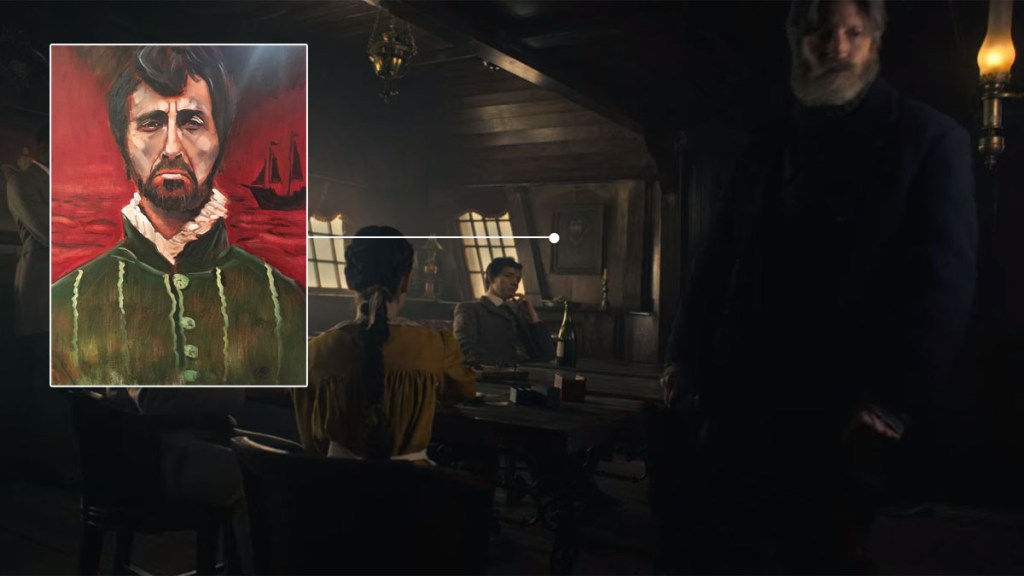
Another fun portrait fact: the faces of production designer Arwel W Jones and art director Harry Trow also found their way onto screen in Dracula. “One of our scenic artists, Jeremy Duckham, is a very, very talented portrait artist, and he did them all, including me,” says Jones. “In the back of shot in the Castle Dracula dining area, you can see me in a red smock as an old cousin of Dracula’s, the count of somewhere, it was based on so-called folklore of a cousin of Dracula. And on the boat, you might notice the face of our art director Harry in that painting as the Tsar!”
Here Be Dragons
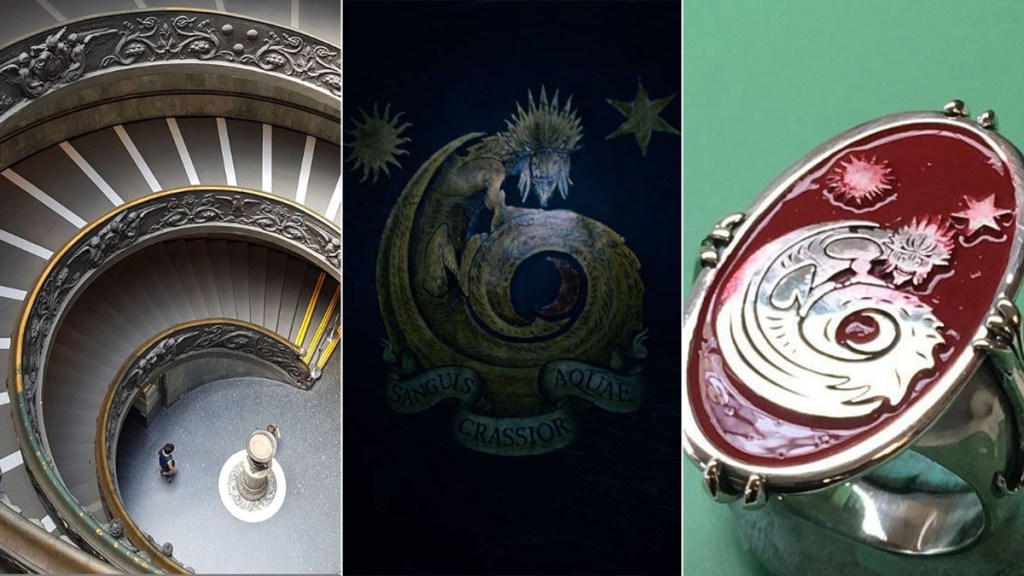
“The name ‘Dracula’ comes from the word ‘dragon’, so that’s why we seeded dragons all the way through,” Jones tells Den of Geek. “There are no elephants this time (a reference to Jones’ favourite animal, which found its way into several Sherlock sets), because it’s all dragons!” Look closely and you’ll see a repeating dragon motif on the door of Dracula’s carriage and on the Count’s ostentatious signet ring. It was designed by “little genius” Richard Wells, the graphic designer who created a series of Dracula family crests evolving through the centuries for the battle standards hanging on the castle walls.
There are also two stone dragons flanking the fireplace and a stone dragon’s head emerging from the lower wall. One of the fireplace dragons is currently standing guard next to Jones’ front door, he laughs. “It does help with deliveries, being able to say ‘it’s the house with the dragon!’”
One feat of dragon-related design is in Castle Dracula’s monumental staircase, which mirrors Wells’ family crest design. “The tail of the dragon is actually the same spiral as the staircase,” explains Jones. “So if you look from the top shot, the head of the dragon on the wall on the grand staircase is actually in the same position as the head and tail are. It’s another reflection of the same logo.”
Stairway to Hell
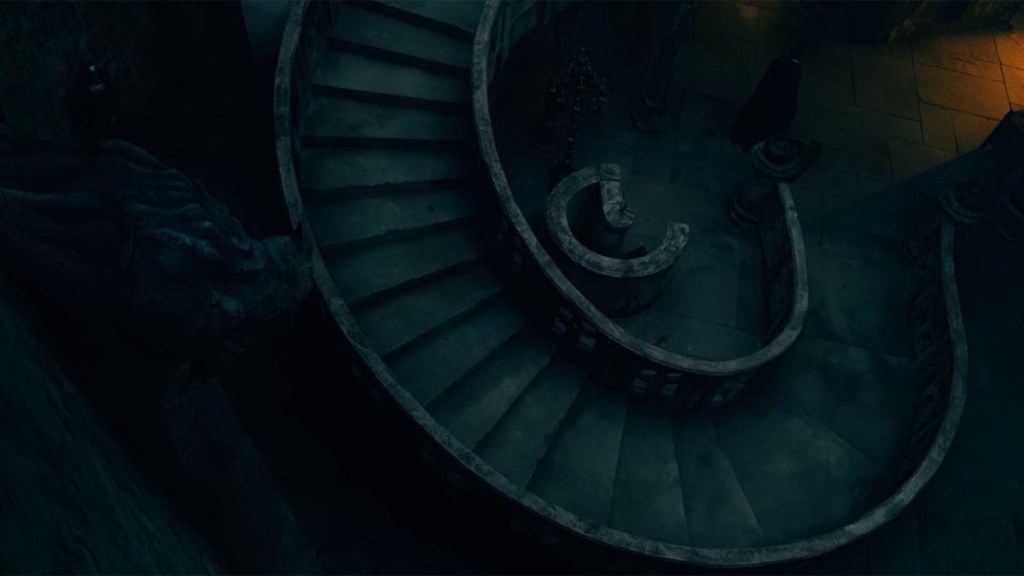
The design for Castle Dracula’s impressive staircase had been in Jones’ head for a while, just waiting for the right project. Its inspiration? The Vatican Museums in Vatican City, Italy (see ‘Here Be Dragons image above). “The way you leave the Vatican Museums is this Fibonacci spiral staircase, so when you stand at the top, it spirals downwards but inwards at the same time,” Jones explains. After visiting the museum, the image stayed with him. “When the offer of doing Castle Dracula came along, it just felt right, to spiral upwards and outwards for the entrance way, because you’d then have a central point where Dracula would come down the stairs but it would widen out as it went up, which would give you that sense of scale as you went up, and you’d be able to look up the tower.”
The Vatican museum version doesn’t have the Gothic skull motif in the stone balustrades, laughs Jones. “Theirs is a bit more high-end! I like my skulls, they tend to drop in everywhere. I wanted the interplay of light and shadows, to create that sense of unease for the viewer.”
A Tribute to Hannibal Lecter
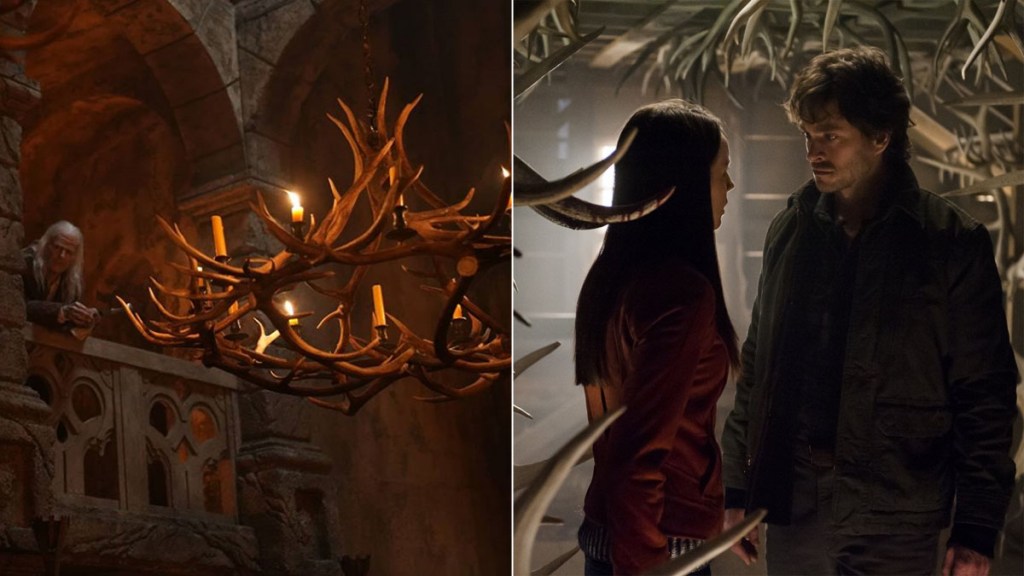
Hanging high above Dracula’s dining table is a striking antler chandelier, which Jones included as a specific nod to another great horror icon: Dr Hannibal Lecter. “I hadn’t long binged Bryan Fuller’s Hannibal show, where there was a lot of antlers and death and rich colours,” remembers Jones. “All those two-hander scenes between Hannibal and Will, in my head, were mirrored by the scenes between Jonathan and Dracula – the kind of hunter and prey idea.” When set decorator Hannah Nicholson showed him the antler chandelier (imitation, but they look very real), Jones thought it the perfect hat tip to Fuller’s Hannibal.
Dragon’s Den
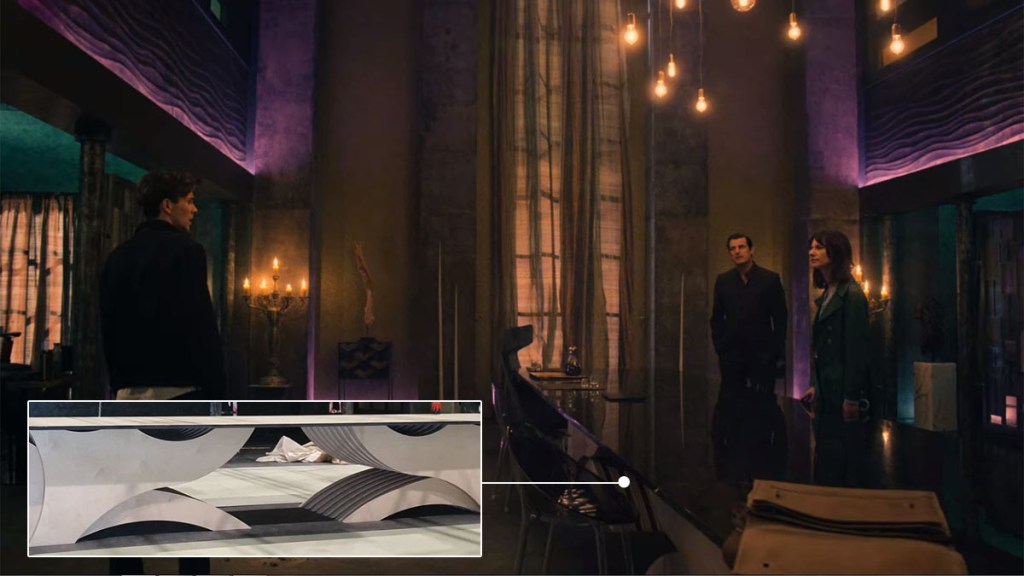
Just because a vampire wakes up in a new century doesn’t mean he won’t want to surround himself by reminders of home. Dracula’s flash London pad in episode three ‘The Dark Compass’ was designed to echo his castle. “Once I started playing with mirroring what we had in the castle, it started to come together,” says Jones. “I had the window where the fireplace was, as far as the dining table was concerned, then the entrance opposite, then we dotted things around that reflected what was in the castle – artwork, sculptures – things to replace the suits of armour.”
One particular nod to Castle Dracula was so subtly done that even episode director Paul McGuigan didn’t spot it. “I’d mentioned to Paul that I wanted to get the dragon in there and he really wasn’t sure, so I didn’t tell him that I put it in the stands for the table,” Jones laughs. “I got Rebecca Gresham, my draughtsperson, to do a very, very abstract version of the dragon’s head in profile and then we divided it up into two shapes and got a lot of sheets of plywood cut out in those two shapes and then sandwiched them over and over to give us that profile.” On set, Jones pointed it out to McGuigan. “The fact that he hadn’t noticed meant it had worked – subliminal, better than in your face!”
Man in the Mirror
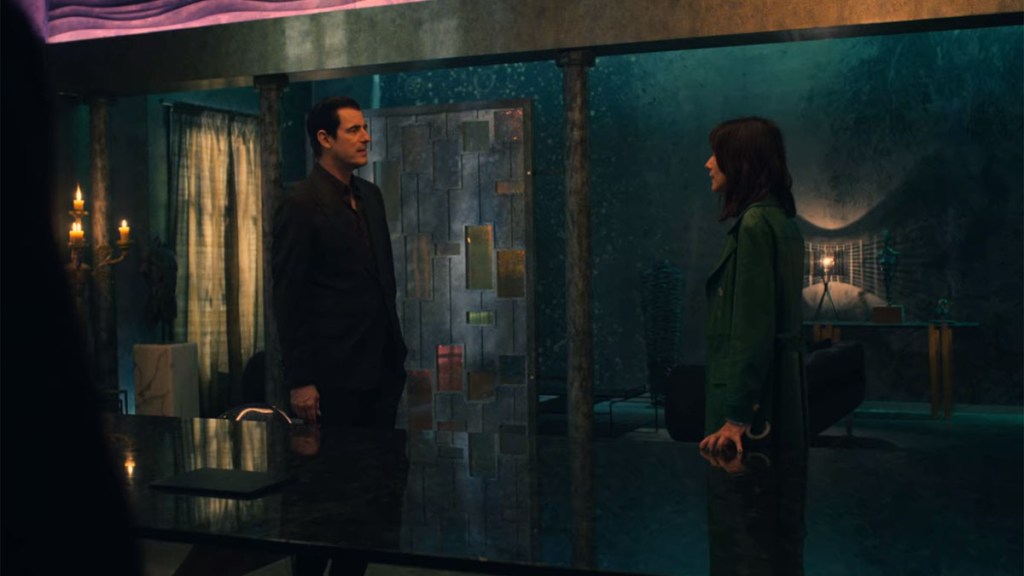
Part of the mythology established in the BBC/Netflix Dracula is that mirrors show ‘the truth’. For the Count, mirrors work as a kind of ‘picture of Dorian Gray’, so that when he looks into one, he sees his real self – a centuries-old monster and not the handsome man seen by the rest of the world. That’s why the glass-artwork and reflective surfaces in Dracula’s apartment are all broken up, says Jones. “Like the big window, they’re all disguised. In his reflection, he could see the real thing, rather than whatever people see, so that was a horror to him. It was all about breaking up reflections rather than seeing one very clear image.”
The rest of the apartment design was about grandeur of scale and opulence, says Jones. “Where would this centuries-old warlord live in London? There was nothing out of his grasp, he could get whatever he wanted.” While Castle Dracula was all about creating a sense of unease, this was about creating a sense of his comfort. “He was quite happy in this space. Dracula’s happy in the 21st century! They have a little joke about him putting weight on because the food comes to him, he doesn’t have to go hunting!”
Here Comes the Sun
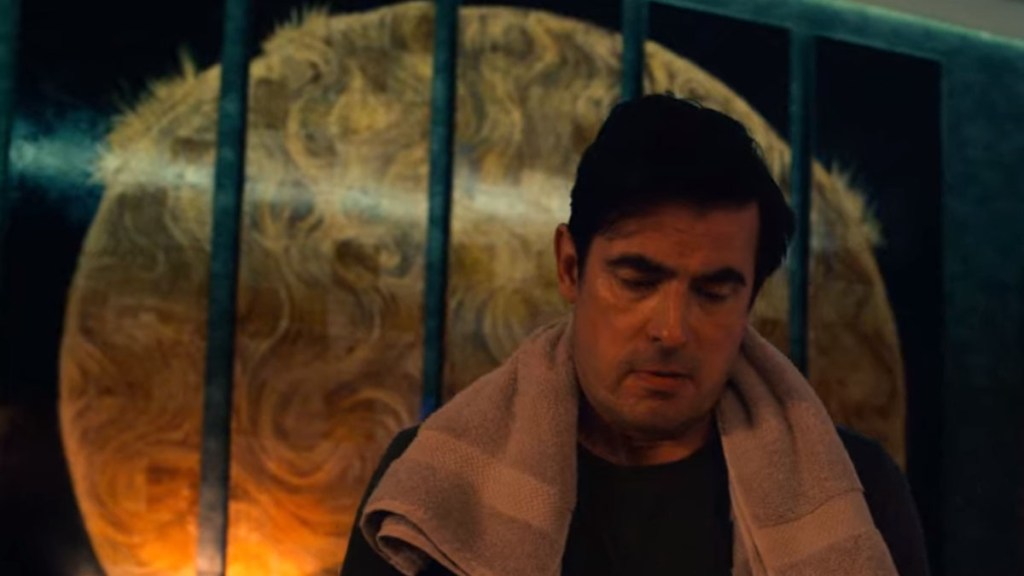
Another repeated motif across Dracula’s two homes is his obsession with the sun. “Throughout the castle, there were lots of references to the sun because of his fascination with it and the fact that he’s not seen it in centuries. Our scenic artists painted a few bits of artwork that had the sun rising over the castle and various things to do with sunrises and sunsets, to reflect that.”
One monumental tribute to the sun was found on the wall of the Count’s modern-day apartment. “The big gold-leaf sun is a five-piece artwork made from separate canvases to divide it up. We gave the artists a few different references – a mixture of Gustav Klimt and some amazing Japanese artists.”
Scarface Easter Egg
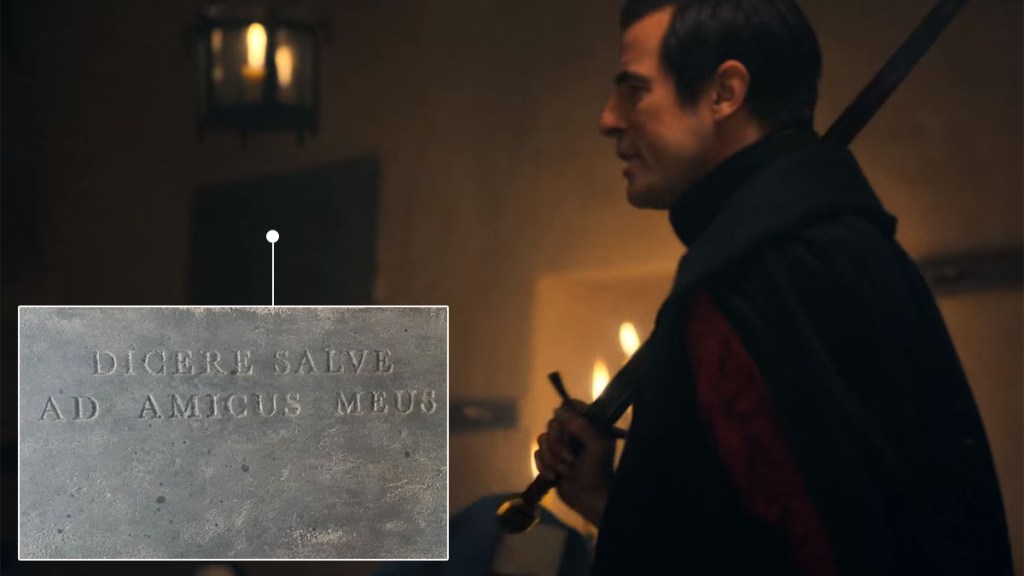
Unless your TV is higher-definition than the Hubble telescope, you won’t have seen this on screen, but it was there. In episode one, on the wall of the convent chapel where Dracula beheads the Mother Superior, is a stone tablet engraved with a Latin carving: Dicere Salve Ad Amicus Meus.
“When we film in real locations, especially in chapels, sometimes you have remembrance stones or things with real people’s names on, so we have to make something to cover them up,” explains Jones. “Because I’d done a little gag in Sherlock many years ago – at the end of ‘A Scandal in Belgravia’, when Irene Adler is about to get decapitated and Sherlock rescues her, there’s a gun on the back of a Toyota pick-up truck and on the side of the truck it says ‘Say hello to my little friend’ from Scarface in Arabic – I got them to do a Latin version of the same line. The gag was that there was a big gun on the pick-up truck, and in this scene it was Dracula with a big sword.”
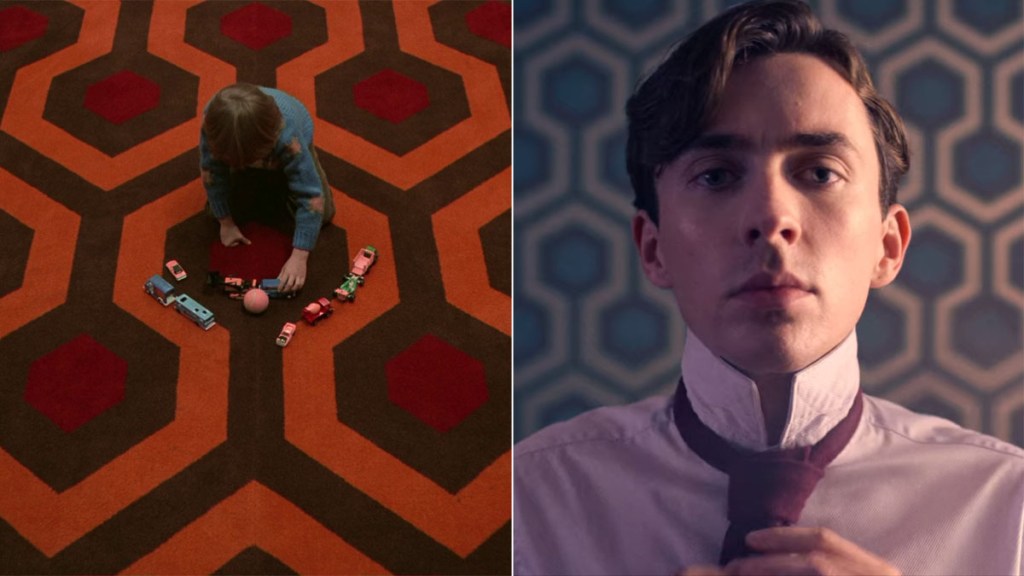
Another movie reference came in the form of the wallpaper (an Arwel W. Jones speciality!) at the flat of Harker Institute scientist Jack Seward. “It’s another nod towards being uncomfortable and uneasy,” says Jones, “and a little tribute to The Shining.”
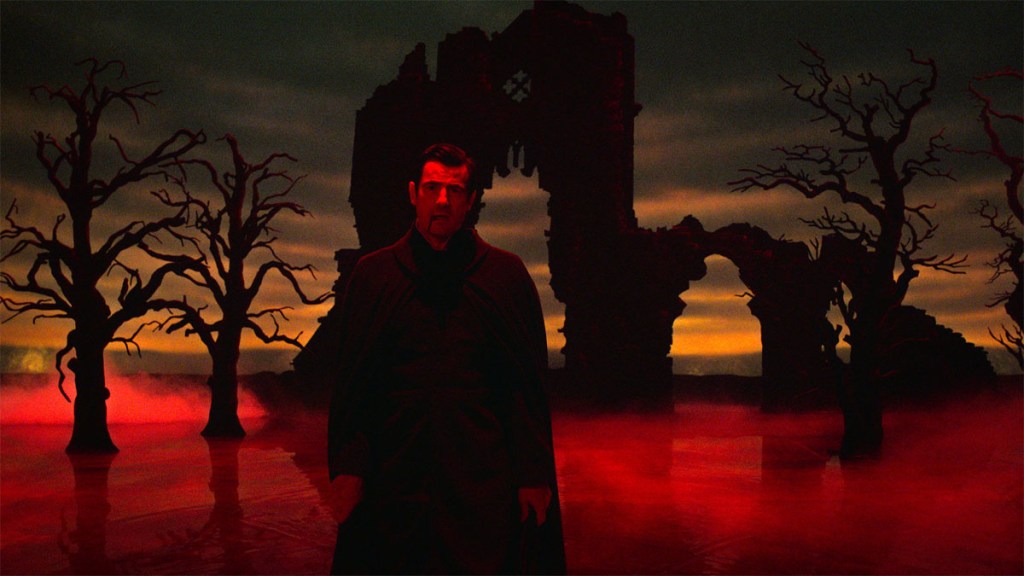
Mark Gatiss specified a particular sequence from cult director Roger Corman’s back catalogue as the reference for Dracula’s theatrical vision in episode two (there’s a definite The Fall of the House of Usher feel). “This was meant to be a nightmarish set-up due to the fact that he was being poisoned. It was all about those silhouetted trees. The blood on the floor was my idea, to give those perfect reflections. It was quite a feat to be honest with you!”
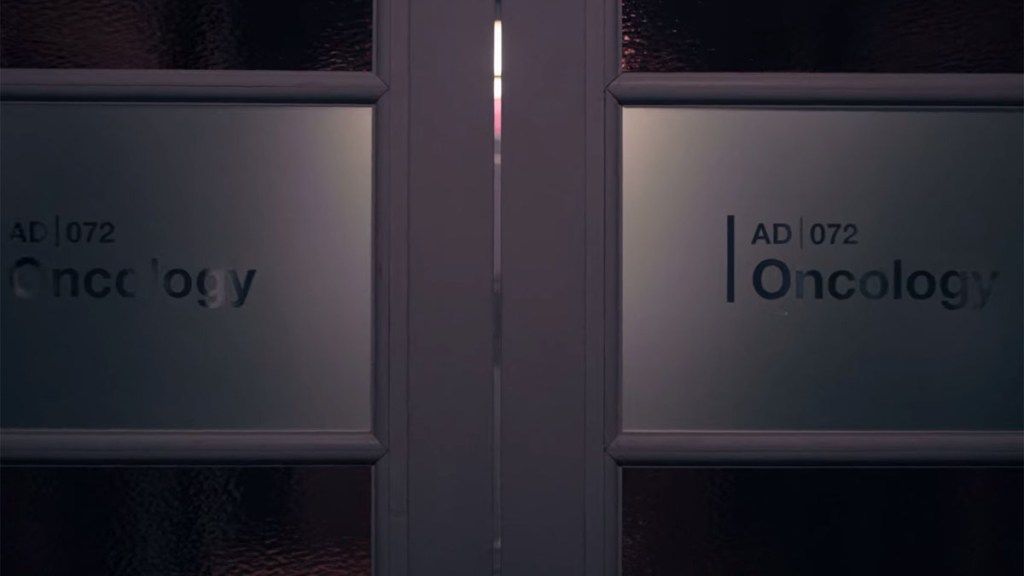
And finally, who spotted the name of the AD 72 laboratory at the Harker Institute and saw the link to the cult Alan Gibson-directed Dracula Hammer picture?
There is No Baby, Johnny
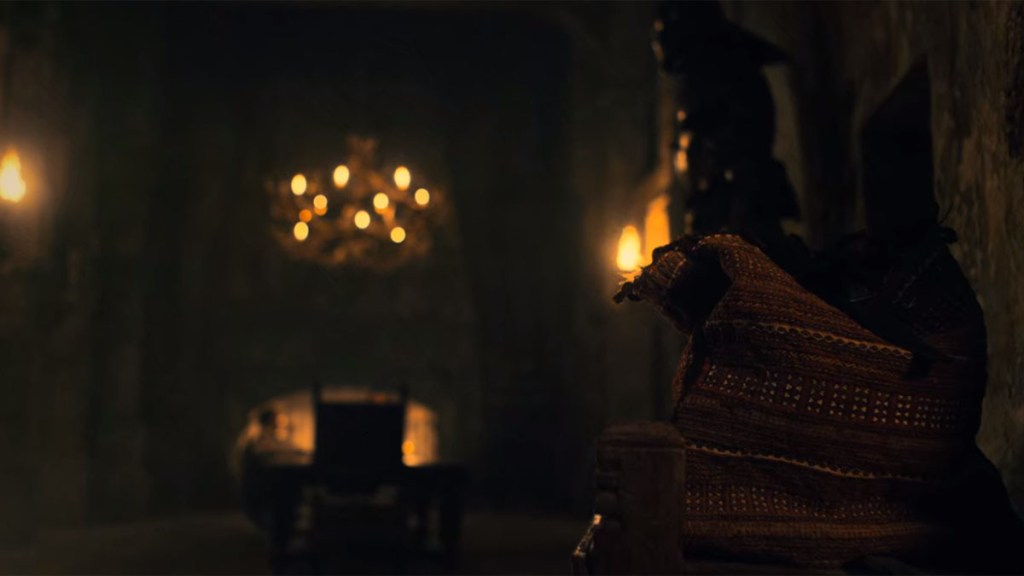
The feeding machine Jonathan Harker discovers on his manic exploration of the castle was built according to detailed specifications from Steven Moffat’s script. “He’d had this idea in his head of these feeding bowls where the brides were trapped in boxes and he was feeding them on different things in order to see what would happen, as an experiment. There’s flies in one, rats in another and obviously, the baby in the third…”
The baby is a grotesque highlight of episode one – first introduced unseen but squirming and squalling inside a carpet bag as Dracula deadpans to his houseguest that “there is no baby, Johnny.”
“There are some videos that may come to light one day of us doing various things to try and get that bag to move like there’s a baby in it,” laughs Jones. “It was very funny. We had electric drills with things attached to them, some of those baby doll toys that crawl along the floor, we had little jumping toy dogs…”
Dracula’s Cell

Director Paul McGuigan’s original mood board for episode three included a picture of a silhouetted Dracula within a lit triangle, an image recreated for the night club scene, lit by lasers. “Triangles were a theme throughout episode three,” explains Jones. Dracula’s triangular cell was designed as a reflection of that – thematically and literally. “By having glass in three walls, it means you get lots of refraction and reflection with lights without them necessarily reflecting straight back into camera, even though I’m sure the cinematographer Tony [Slater Ling] would say it’s an absolute nightmare to light,” laughs Jones. “It did look great in the end, because every little light we had on the walls pinged around everywhere.”
The Game is Afoot!
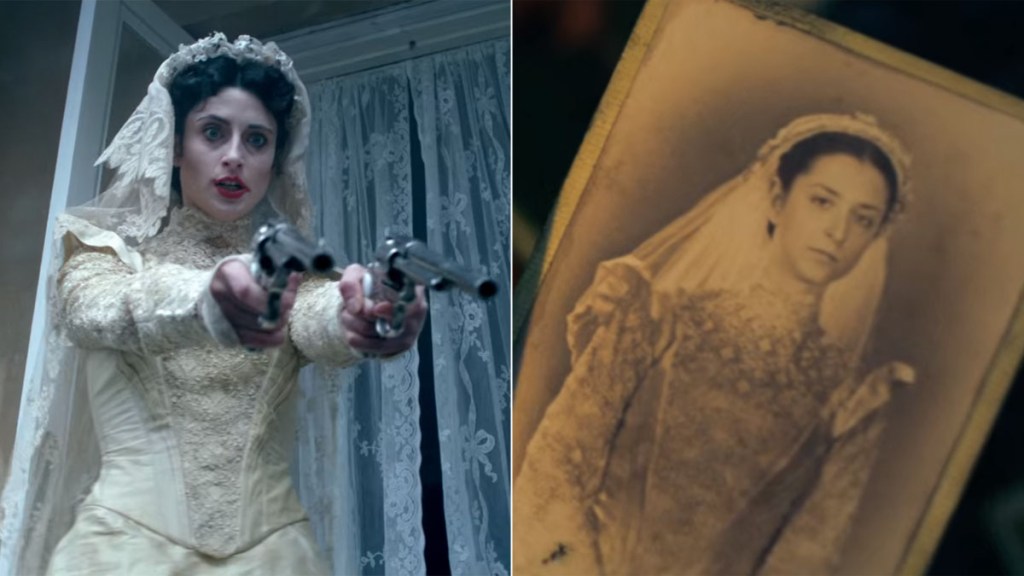
With Sherlock and Dracula both written by Steven Moffat and Mark Gatiss, produced by Hartswood Films, and employing many of the same creative teams, a little bit of one was bound to bleed into the other. In addition to Sister Agatha’s “I have a detective acquaintance in London” reference to the man himself, some costumes found their way across the border. Costume designer Sarah Arthur recycled the coat from Martin Freeman’s Victorian John Watson look from Christmas special ‘The Abominable Bride’ to use in Jonathan Harker’s travelling outfit. Look closely at the photograph Harker takes out of the zombie boxes and you’ll recognise the wedding dress as that worn by the Emelia Ricoletti, the titular bride herself.
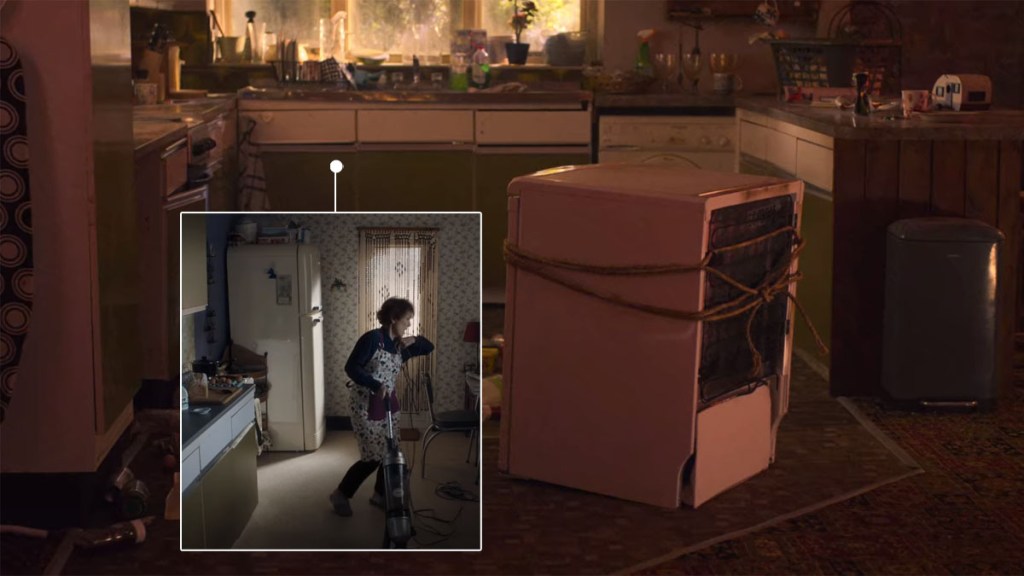
Not only that, but look at the kitchen units at Bob and Katherine’s house in Dracula episode three, and you might recognise them as formerly belonging to a landlady of Baker Street. “You recognised the kitchen?” asks Jones. “It’s Mrs Hudson’s kitchen!”
Dracula is available to stream now on Netflix. Design detail photos courtesy of Arwel W Jones.

